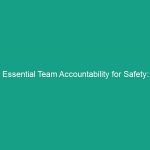Introduction
In the world of manufacturing, the health, safety, and Environment (HSE) practices are paramount. The manufacturing industry is often viewed as a backbone of the economy, providing jobs and producing goods that society relies on daily. However, with these contributions come significant risks. Safety in manufacturing is not just a regulatory requirement; it is a fundamental responsibility that every stakeholder must prioritize. Understanding and implementing effective Safety Measures can prevent accidents, injuries, and even fatalities, ensuring that the workplace is conducive for all employees.
The importance of Workplace Safety cannot be overstated. Every year, thousands of workers face injuries, many of which are preventable through the adoption of Safety protocols and Best Practices. This article aims to provide comprehensive guidelines that highlight the essential Safety Measures within the manufacturing sector, ensuring that both employers and employees are well-informed about the Best Practices to avoid risks.
Regulatory Frameworks in Manufacturing Safety
Understanding the regulatory frameworks governing safety in manufacturing is crucial for compliance and risk management. Various organizations and governments have established guidelines and Regulations to ensure safe working conditions.
Key Regulatory Bodies
Several key regulatory bodies oversee safety in manufacturing. In the United States, the Occupational Safety and Health Administration (OSHA) is the primary agency responsible for enforcing Workplace Safety standards. osha sets and enforces Standards, provides Training, and emphasizes the importance of safety in the workplace. Similarly, the Environmental Protection Agency (EPA) plays a vital role in regulating Environmental Safety, ensuring that manufacturing processes do not harm the community or the ecosystem.
International Standards
Beyond national regulations, international standards such as those set by the International Organization for Standardization (ISO) also play a significant role in promoting safety in manufacturing. ISO 45001, for instance, focuses on Occupational Health and safety management systems. This standard provides a framework to improve employee safety, reduce workplace risks, and create better working conditions.
Compliance and Best Practices
Compliance with these regulations is not merely a legal obligation; it is a commitment to fostering a culture of safety within an organization. Regular audits, employee training, and adherence to established protocols ensure that manufacturers remain compliant while prioritizing the well-being of their workforce. Proactive compliance measures can also mitigate the risk of costly legal issues and reputational damage associated with workplace accidents.
Best Practices for Safety in Manufacturing
Implementing best practices is essential for ensuring safety in manufacturing. These practices not only protect workers but also enhance overall productivity and morale.
Risk Assessment and Mitigation
A thorough risk assessment is the foundation of any safety program. Identifying potential Hazards, evaluating risks, and implementing appropriate Control Measures can significantly reduce the likelihood of accidents. Regularly revisiting risk assessments allows manufacturers to adapt to new challenges and continuously improve safety protocols.
Employee Training and Engagement
Training is a critical component of safety in manufacturing. Employees must be educated about potential Hazards and trained in safe operating Procedures. Engaging employees in safety discussions and decision-making fosters a culture of safety where everyone feels responsible for their own well-being and that of their colleagues. Regular safety drills, workshops, and refresher courses can keep safety at the forefront of employees’ minds.
Use of Personal Protective Equipment (PPE)
Personal Protective Equipment (PPE) is vital in mitigating risks associated with manufacturing processes. Employers should provide appropriate PPE, such as helmets, gloves, goggles, and ear protection, tailored to specific job requirements. Furthermore, it is essential to ensure that employees are trained in the correct use and Maintenance of PPE to maximize its effectiveness.
Creating a Safety Culture
A safety culture is an environment where safety is prioritized by all employees, from management to frontline workers. Encouraging open communication about safety concerns, recognizing safe behaviors, and learning from incidents can foster a culture that values safety. Leaders play a crucial role in modeling safety behaviors and championing initiatives that promote a safe workplace.
Case Studies: Learning from Real-World Scenarios
Analyzing case studies can provide valuable insights into effective safety practices and the consequences of negligence. By examining real-world scenarios, manufacturers can learn from others’ experiences and implement necessary changes to their safety protocols.
Case Study 1: The Importance of Comprehensive Training
A leading automotive manufacturer faced significant challenges with workplace injuries due to improper handling of machinery. After a thorough investigation, it was discovered that many employees had not received adequate training on new equipment. In response, the company revamped its training program, incorporating hands-on sessions and regular assessments. As a result, workplace injuries decreased by 40% within the first year, highlighting the critical role that training plays in ensuring safety in manufacturing.
Case Study 2: Proactive Risk Assessment
A food processing plant experienced several near-miss incidents due to slip and Fall Hazards. The management decided to conduct a comprehensive risk assessment, identifying high-risk areas and implementing remedial measures such as improved drainage systems and non-slip flooring. Following these changes, the facility reported no slip and fall incidents in the subsequent year, demonstrating the effectiveness of proactive risk management.
Challenges in Ensuring Safety in Manufacturing
Despite the best intentions, several challenges can hinder the implementation of effective safety measures in manufacturing.
Resistance to Change
One significant challenge is resistance to change from employees and management alike. Many individuals are accustomed to established routines and may be hesitant to adopt new safety practices. It is vital for leaders to communicate the Benefits of these changes and involve employees in the process to overcome this resistance.
Resource Constraints
Manufacturers often face budget constraints that can limit their ability to invest in safety initiatives. However, it is essential to view safety as an investment rather than a cost. Allocating resources to safety measures can lead to reduced accident rates, lower insurance premiums, and higher employee morale, ultimately benefiting the bottom line.
Keeping Up with Regulations
The dynamic nature of regulatory frameworks can also pose challenges for manufacturers. Staying updated with the latest regulations and ensuring compliance can be overwhelming, especially for smaller manufacturers with limited resources. Establishing a dedicated safety team or partnering with external consultants can help manage these challenges effectively.
Future Trends in Manufacturing Safety
As the manufacturing industry evolves, so do the practices and technologies aimed at enhancing safety. Staying informed about future trends can help organizations remain ahead of the curve.
Technological Advancements
Technological innovations, such as automation and artificial intelligence, are transforming the manufacturing landscape. These technologies can enhance safety by minimizing human error and reducing exposure to hazardous conditions. For example, robots can perform dangerous tasks, decreasing the likelihood of injuries among workers.
Data-Driven Safety Management
Data analytics is becoming increasingly important in safety management. By analyzing data from safety incidents, manufacturers can identify patterns and implement targeted interventions. This data-driven approach allows for continuous improvement in safety protocols and can lead to a more proactive safety culture.
Emphasis on Mental Health
Furthermore, there is a growing recognition of the importance of mental health in the workplace. Stress, anxiety, and burnout can significantly affect employee safety and productivity. Organizations are beginning to implement mental health programs and support systems to promote overall well-being, recognizing that a healthy workforce is a safe workforce.
Conclusion
Ensuring safety in manufacturing is a multifaceted responsibility that requires commitment, awareness, and proactive measures. By understanding the regulatory frameworks, implementing best practices, learning from case studies, addressing challenges, and embracing future trends, manufacturers can create a safe working environment for all employees. The journey towards safety is continuous; it demands vigilance and dedication from everyone involved. As you move forward, prioritize safety, invest in training, and foster a culture of open communication. Together, we can reduce risks and ensure that every worker returns home safely at the end of the day.


